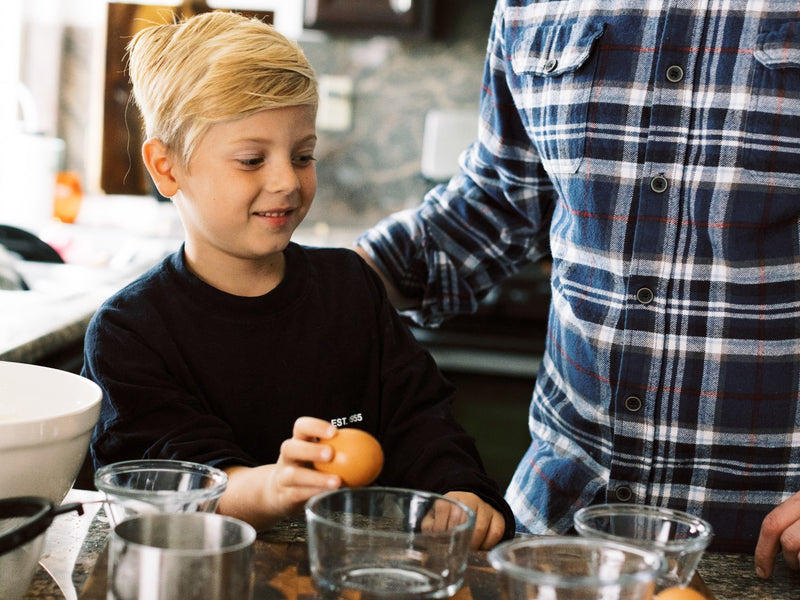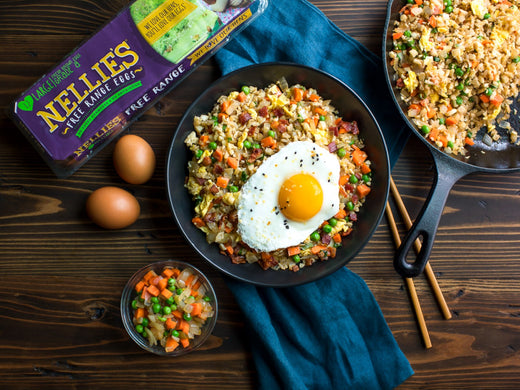
Learning how to crack an egg without breaking the yolk or getting shards of shell in the whites takes some time, even for the most experienced home cooks.
Luckily, having a high quality free range egg with an exceptionally thick shell and substantial yolk helps. Once you've mastered that, there's even more patience and skill required to successfully separate eggs for that yummy toasted meringue or extra creamy hollandaise sauce you're making. For this endeavor, there are countless methods, tips, and hacks, but these three easy techniques are tried and true in our kitchens, and will yield a flawlessly separated egg yolk and egg white every time.
How to crack an egg cleanly
Before you can separate your yolks and whites, you'll have to crack open your egg without disturbing the contents inside. Despite what instinct tells you (and what many of us learned growing up), eggs should always be cracked on a flat surface, such as a hard counter top or a cutting board. When you crack an egg on the edge of a bowl, table, pan, or any other non-flat surface, you increase the risk of that edge puncturing the yolk at point of contact, causing it to break apart, leaving you with an impossible-to-separate mess of yolk and whites, and dashing your dreams of a perfect sunny-side up egg for breakfast. Cracking an egg on the edge of something also tends to yield more shell shards, which can break off and end up in your cake mixes and pancake batters.
How to separate an egg
From using a snazzy tool to putting the shell to work, there are many, many ways to separate an egg. Here are the three easiest, most foolproof methods.
1. Use an egg separating tool
Using a tool meant specifically for the job is the safest bet when it comes to separating eggs, but it also tends to be more time consuming and expensive than other methods. Commonly known as egg separators, these tools can be found online, at grocery stores, and anywhere that sells kitchen appliances and accessories.
What is an egg separator?
While each differs slightly, most egg separators function by catching the yolk while allowing the white to drip through to a cup or bowl below. From there, you can gently tilt the egg separator into a "yolks only" bowl and move on to your next egg. The downside here is the time it takes for the white to slowly drip off of the yolk, which can be a nuisance when you're separating more than one or two eggs. In some cases, thick whites like the ones you'll find in our eggs may not naturally detach from the yolk, no matter how long they sit in the tool.
Types of egg separators
The most common types of egg separators include stainless steel or plastic "strainers" that eggs can be cracked right into while gravity does the work of pulling the whites downward and into your bowl. Others use suction to help you remove the yolk from an egg that has already been cracked into a bowl. No matter which type you choose, the biggest downside of this method is that you'll have to purchase a special gadget rather than using items (like the shells or your own two hands) that are free and already at your disposal.
2. Use the shell
The shell swap, the shell rock, the shell switch...whatever you choose to call it, this method is a favorite among skilled cooks and bakers. It requires no fancy tools, but takes a bit of time and skill to master.
How to separate eggs with the shell
First, crack your egg against a flat surface, doing your best to cleanly split the shell in half by prying open and upwards with your thumbs over a large bowl. Aim to catch the yolk in one of the shell halves as the white drips down into the bowl below. Most likely, and especially if the eggs are very fresh or straight from the refrigerator, some of the white will still be attached to the yolk. At this point, carefully transfer the yolk back and forth between the two shell halves. After a few passes, all the white will have dripped over the edge of the shell and into the bowl below. When using this method, be careful not to let the sharp edges of the two shell halves puncture the yolk while you transfer it back and forth.
3. Fish out the yolks by hand
Ever wondered how the pros separate those bulk batches of eggs in bakeries, restaurants, and cafés? Most use the yolk fishing method. It's hands-down the fastest way to separate a large number of eggs, and requires nothing but your hands and a bowl.
How to separate eggs by hand
To begin, crack your eggs into a large bowl. This method works for any number of eggs; you're only limited by the size of your bowl. Next, use clean hands to "fish" the yolks out of the bowl, gently picking up each yolk from below while allowing the whites to drip back down through the slits in between your fingers. Place the yolk in a separate bowl and repeat. You can use a spoon in place of your hand, although most people find that it gives you less control over those slippery yolks. Until you're comfortable with this method, try cracking your eggs in batches of three or four, then moving your clean whites into a new bowl before cracking another round, just in case one of your future yolks breaks.
Tips and tricks for perfectly separated eggs
No matter how skilled you are at separating eggs, things happen: yolks break, shells shatter, and you forget to let your eggs come to room temperature for meringue. To avoid letting any mishaps interfere with your recipe, keep these tips and tricks in mind.
I accidentally got some yolk in my egg whites. Can I still use them to make meringue?
If it's just a drop or two, you can use one of your cracked shells to carefully fish out any yolk in your bowl of egg whites. If you're confident that you got every last drop out, you can still successfully use the whites for meringue. Yolk contamination is only an issue if you're looking to whip the whites to soft or stiff peaks. The fats in egg yolks interfere with the proteins in the whites that are responsible for building that beautiful, airy structure needed to make meringue. If your whites aren't completely free from yolk, you'll find it impossible to properly whip them, no matter how long you leave your mixer running. For this same reason, always ensure that the bowl you collect your egg whites in is extra clean, as any grease or fat in the bowl can interfere with whipping.
I can't get all the whites separated from my yolks. Can I still use the yolks for my recipe?
This is usually unavoidable. The fresher the egg and the thicker the white, the harder it is to remove from the yolk entirely. The good news? A little bit of egg white in your yolks most likely won't cause any issues in the recipe you're making.
Are cold or room temperature eggs easier to separate?
Cold eggs are sturdier, firmer, and less likely to break, but because the whites are stiffer, they can be harder to separate from the yolks. If you're not confident in your egg separating skills quite yet, using eggs straight from the fridge will help you avoid yolk breakage.
Room temperature eggs are looser, making them easier to separate quickly and in large batches. The only downside is that the yolks are more likely to break once they've warmed up a bit, so this method is best for seasoned home cooks and bakers.
What is that stringy white thing in my eggs?
The white stringy bit that you see on the yolk, floating around in the white, or connecting the two is called the chalaza. Chalazae are thin, ropey strands that anchor the yolk in place in the center of the white when the egg is formed. They are neither imperfections nor embryos forming, though they're often mistaken for either of the two. Chalazae are known to diminish as the egg ages and don't interfere with the cooking or beating of the white, although some people choose to remove them before cooking out of preference. This can be done with a spoon, chopstick, shell, or your fingers.
Are eggs with blood safe to eat?
Blood spots are completely safe to consume, and are the result of a ruptured blood vessel on the yolk's surface as the egg is forming; a completely normal and benign process for all eggs and the hens that lay them. While you may wish to remove the spot with the tip of a knife and dispose of it, there is nothing in it that's harmful for human consumption.









